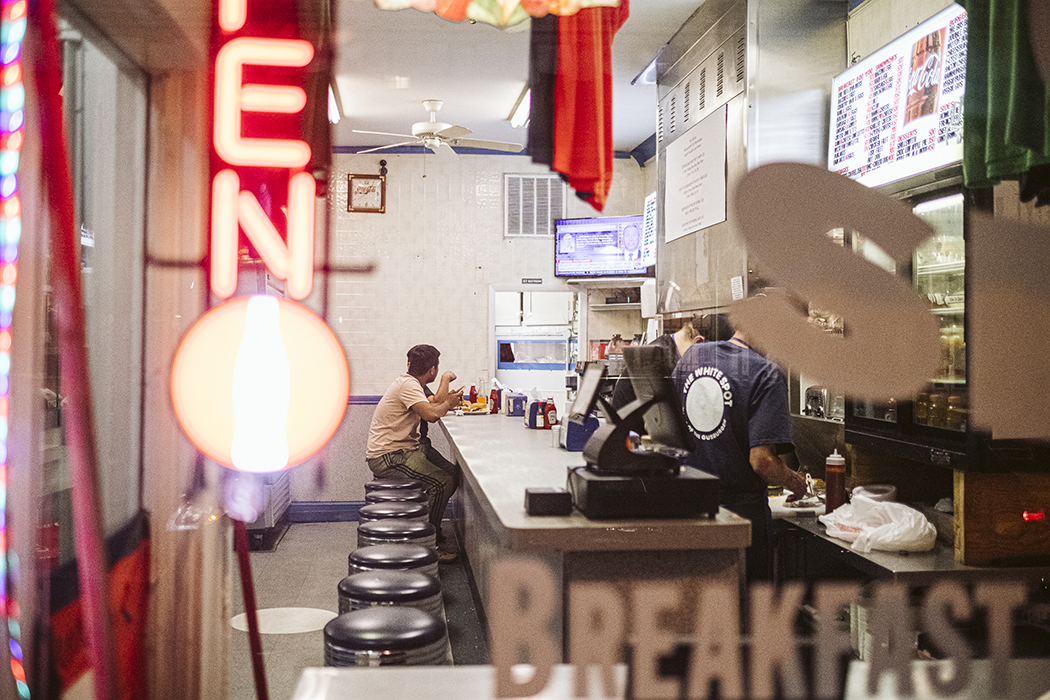Can anything overshadow the legendary Gus Burger at The White Spot?
By today’s standards, the Gus is a humble hamburger sandwich. But it was revolutionary 65 years ago for the fried egg tucked in its bun, and its lore has grown as generations of UVA students have stumbled into The White Spot late at night to sop up the suds in their stomachs.
“You can’t find better,” former White Spot owner Dmitri Tevampis said in a 2014 C-VILLE Weekly interview. “At three in the morning after the bar, you eat the Gus, and you’re done.”
Indeed, the name Gus has grown to be synonymous with the Spot. But another big name now shares the marquee. Ralph Sampson, the former UVA basketball great and Naismith Memorial Basketball Hall of Famer, is part of an ownership group that purchased the small grill and dining room on the UVA Corner in January.
“Sometimes investments are heartfelt, and about tradition and legacy,” Sampson says. “It was done for the right reasons. The traditions in Charlottesville are very special.”
Sampson said the 15-person ownership group, which has “more things to come in Charlottesville,” is composed of UVA alumni and at least three former White Spot employees.
According to Sampson, the new ownership team isn’t likely to change much at the Spot. “Maybe a few additions,” he says. “It just needs some TLC. Why change something everyone loves?”
That means the Gus Burger should remain the same as it has been since around 1955: an all-beef patty topped with cheese, egg, lettuce, and tomato.
Like the memories of so many who’ve enjoyed the Gus, the hamburger’s history is a bit fuzzy. Paul Dunsmore founded The White Spot at 1407 University Ave. in 1953. He memorialized the Gus a few years after opening, naming the burger in honor of Dr. Gus Egor, who the diner’s website indicates would “traverse University Avenue daily to order a cheeseburger topped with a fried egg.” No record of a professor Egor at UVA is readily available, however.
Dunsmore always said it was the decision to keep The White Spot open nearly all night that drove its success and kept the Gus on folks’ minds. The restaurant offered nothing more than a counter and kitchen when Dunsmore built it out of a former beauty salon, but third owner Tevampis expanded in 2005. Annexing the neighboring space formerly occupied by a jewelry and gift store, The White Spot added tables to the 11 counter barstools it solely relied on for 50 years.
Tevampis worked The White Spot tirelessly for two decades and was a constant champion of the Gus and the diner’s other delicacies like the Grillswith, two grilled Krispy Kreme donuts with a scoop of ice cream. “First you have the Gus, then the Grills,” Tevampis said in the 2014 interview. “A lot of people, as soon as they come to the airport, they come straight here. The White Spot—everybody knows it, young and old people. Everybody who passes through the university. That is the same with the Gus. These people come here, they say it is the best burger.”
Not all local burger bingers agree that the Gus is still tops, but it has its supporters. “I had never heard of a fried egg on a burger before moving to town, but it was a light-bulb moment,” local sandwich enthusiast and UVA employee Geoff Otis says. “The Gus Burger is great because you get to step outside the typical extravagant toppings that pile up so high you can barely fit the thing in your mouth. Plus, you get to eat it in The White Spot.”
Sampson, too, says he enjoyed a few Gus Burgers during his time at UVA. A skinny kid trying to fill out a gigantic 7’4″ frame, he recalls, “I wanted to gain weight, so I could eat whatever I wanted.”
During his own tenure at the Spot, Tevampis refused to tinker with tradition. Want toppings on your Grillswith? No way. Want the fried egg on your Gus over-easy? Forget about it. “I try to keep it always the same—I don’t want to change,” he told C-VILLE. “Got to be dry—it’s more safe.”
Tevampis launched the annual Gus Burger eating contest in 2002, and the springtime event has attracted national media attention and countless gustatorial feats. This past April’s eating contest champion downed four burgers in just six minutes—the time limit for the contest—and the record is said to be eight Guses in a single sitting.
But for Sampson and so many other Wahoos, the Gus lives on not because of annual media coverage, but because of its accessibility on the Corner and its ability to satisfy those late-night munchies.
“Everyone has a memory of The White Spot after a game,” Sampson says. “I lived on the Lawn my senior year, and walking from room number six to the Corner definitely provided me a lot of memories.”






